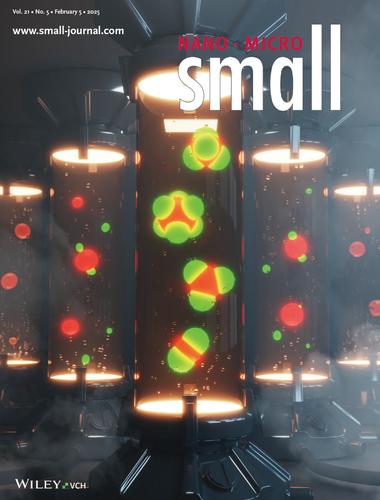Spontaneous Formation of π-Conjugated Polymeric Colloidal Molecules Through Stepwise Coacervation and Symmetric Compartmentalization (Small 5/2025)
IF 12.1
2区 材料科学
Q1 CHEMISTRY, MULTIDISCIPLINARY
引用次数: 0
Abstract
Polymeric Colloidal Molecules
In article number 2404934, Osamu Oki, Yohei Yamamoto, and co-workers demonstrated the spontaneous formation of colloidal molecules through the self-assembly of two types of π-conjugated polymers. The sequential coacervation and growth of the polymers forms compartmentalized droplet clusters, which grow with arranging the satellite droplets symmetrically and solidify without losing the morphology.


π共轭聚合物胶体分子通过逐步凝聚和对称区隔自发形成(Small 5/2025)
高分子胶体分子
本文章由计算机程序翻译,如有差异,请以英文原文为准。
求助全文
约1分钟内获得全文
求助全文
来源期刊

Small
工程技术-材料科学:综合
CiteScore
17.70
自引率
3.80%
发文量
1830
审稿时长
2.1 months
期刊介绍:
Small serves as an exceptional platform for both experimental and theoretical studies in fundamental and applied interdisciplinary research at the nano- and microscale. The journal offers a compelling mix of peer-reviewed Research Articles, Reviews, Perspectives, and Comments.
With a remarkable 2022 Journal Impact Factor of 13.3 (Journal Citation Reports from Clarivate Analytics, 2023), Small remains among the top multidisciplinary journals, covering a wide range of topics at the interface of materials science, chemistry, physics, engineering, medicine, and biology.
Small's readership includes biochemists, biologists, biomedical scientists, chemists, engineers, information technologists, materials scientists, physicists, and theoreticians alike.
 求助内容:
求助内容: 应助结果提醒方式:
应助结果提醒方式:


